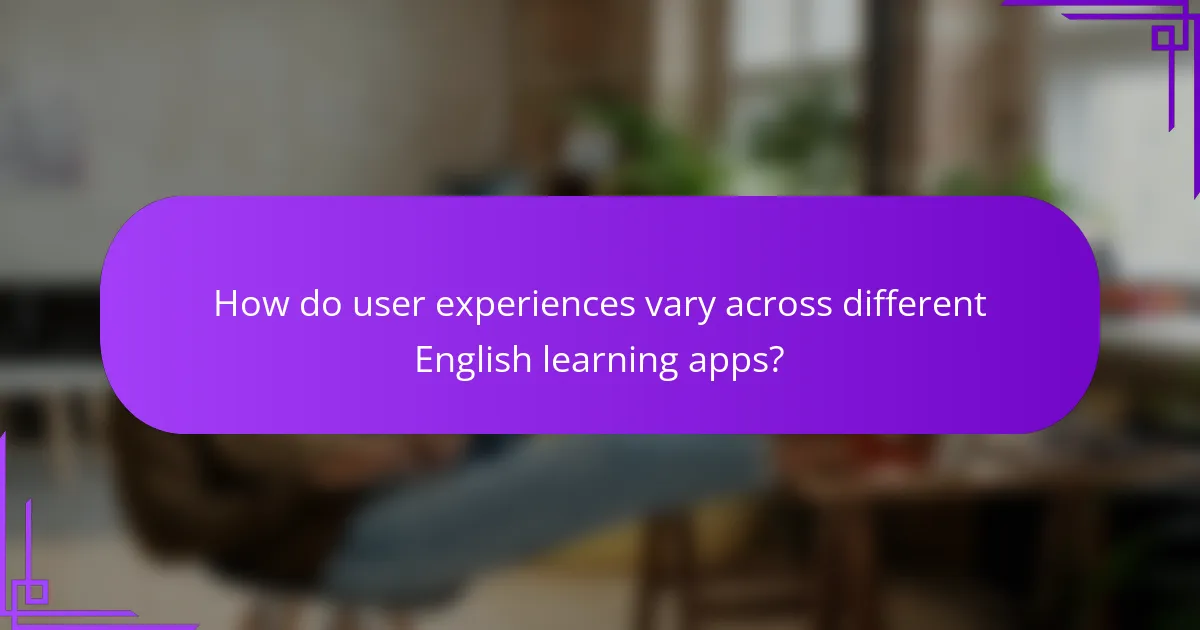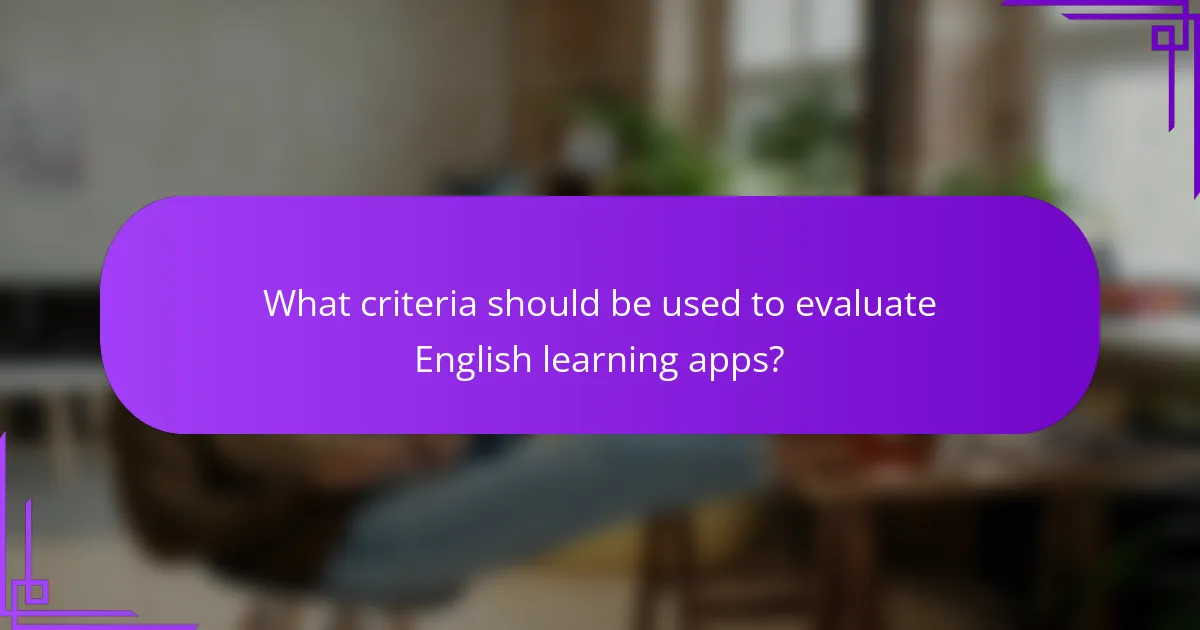Mobile apps for learning English have become increasingly popular, offering diverse features tailored to various learning styles. User experiences can vary widely, influenced by app design, interactivity, and customization options, which ultimately affect engagement and satisfaction. Effective apps often incorporate interactive exercises, progress tracking, and community support to enhance the learning journey.

What are the best mobile apps for learning English in the US?
The best mobile apps for learning English in the US include Duolingo, Babbel, Rosetta Stone, Busuu, and Memrise. Each app offers unique features and approaches to language learning, catering to different preferences and learning styles.
Duolingo
Duolingo is a popular language-learning app that gamifies the learning process. Users engage in bite-sized lessons that cover vocabulary, grammar, and pronunciation through interactive exercises.
The app is free with optional in-app purchases for additional features. Its user-friendly interface and engaging design make it suitable for beginners, while its adaptive learning system helps users progress at their own pace.
Babbel
Babbel focuses on conversation skills and practical language use, making it ideal for learners who want to communicate effectively. The app offers structured courses that are tailored to various proficiency levels.
With a subscription model, Babbel provides access to comprehensive lessons that include real-life dialogues and cultural insights. Users can expect to spend around 10-15 minutes per lesson, making it easy to fit into a busy schedule.
Rosetta Stone
Rosetta Stone is known for its immersive approach, emphasizing learning through context rather than translation. The app uses images and audio to teach vocabulary and grammar intuitively.
This app is subscription-based and offers a robust platform for serious learners. Its speech recognition technology helps users improve their pronunciation, making it a solid choice for those focused on speaking skills.
Busuu
Busuu combines language learning with social interaction, allowing users to practice with native speakers. The app offers personalized study plans and feedback from the community.
With a mix of free and premium content, Busuu is suitable for learners at all levels. Users can engage in speaking and writing exercises, receiving corrections from other members, which enhances the learning experience.
Memrise
Memrise uses spaced repetition and mnemonic techniques to help users memorize vocabulary effectively. The app features a variety of courses created by both the Memrise team and its community.
This app is particularly useful for learners who want to build their vocabulary quickly. With a free version available, users can access basic features, while the premium version offers additional tools for deeper learning.

How do user experiences vary across different English learning apps?
User experiences in English learning apps can differ significantly based on features, design, and customization options. These variations impact user engagement, learning efficiency, and overall satisfaction.
Gamification features
Gamification in English learning apps incorporates game-like elements such as points, badges, and leaderboards to enhance motivation. Users often find that these features make learning more enjoyable and competitive, encouraging regular practice.
For example, apps like Duolingo use a point system and daily challenges to keep learners engaged. However, excessive focus on gamification can sometimes distract from the core learning objectives, so balance is key.
User interface design
The user interface (UI) design of English learning apps plays a crucial role in user experience. A clean, intuitive UI helps learners navigate easily, reducing frustration and enhancing focus on language acquisition.
Apps such as Babbel feature straightforward layouts that prioritize essential functions, while others may overwhelm users with cluttered screens. It’s important for developers to test their designs with real users to ensure accessibility and usability.
Personalization options
Personalization options allow users to tailor their learning experience according to their needs and preferences. This can include adjusting difficulty levels, selecting specific topics, or setting personalized goals.
For instance, apps like Memrise offer tailored content based on user performance and interests. However, too many choices can lead to decision fatigue, so it’s beneficial to provide guided recommendations alongside customization features.

What are the key features of effective English learning apps?
Effective English learning apps typically include interactive exercises, progress tracking, speech recognition, and community support. These features enhance user engagement and facilitate a more personalized learning experience.
Interactive exercises
Interactive exercises are essential for keeping learners engaged and motivated. These can include quizzes, fill-in-the-blank activities, and games that challenge users to apply their language skills in a fun way. Look for apps that offer a variety of exercise types to cater to different learning styles.
For example, apps like Duolingo and Babbel provide gamified lessons that reward users with points and badges, making the learning process enjoyable. Incorporating interactive elements helps reinforce vocabulary and grammar through practical application.
Progress tracking
Progress tracking allows users to monitor their learning journey and stay motivated. Effective apps often feature dashboards that display completed lessons, skills mastered, and areas needing improvement. This visual representation can encourage users to set and achieve specific goals.
Many apps offer daily streaks or reminders to help maintain consistency. Users should choose apps that provide detailed analytics, such as time spent on exercises and accuracy rates, to better understand their learning patterns.
Speech recognition
Speech recognition technology helps learners improve their pronunciation and speaking skills. Apps that incorporate this feature can analyze users’ speech and provide instant feedback, which is crucial for mastering spoken English. This functionality is particularly beneficial for those preparing for speaking exams.
Look for apps that use advanced algorithms to assess pronunciation accuracy and offer corrective suggestions. Tools like Rosetta Stone and Speechling are known for their effective speech recognition capabilities, making them valuable resources for learners.
Community support
Community support fosters a sense of belonging and encourages users to practice their English skills with others. Many effective learning apps include forums, chat features, or social media integration, allowing users to connect with fellow learners and native speakers.
Participating in discussions or language exchanges can enhance the learning experience. Apps like HelloTalk and Tandem emphasize community interaction, enabling users to practice conversational skills in a supportive environment.

How do mobile apps enhance English learning compared to traditional methods?
Mobile apps significantly enhance English learning by offering personalized, interactive experiences that traditional methods often lack. They provide flexible access to resources and tools, making language acquisition more engaging and efficient.
Accessibility and convenience
Mobile apps allow learners to access English language resources anytime and anywhere, breaking the constraints of traditional classroom settings. This flexibility means users can practice their skills during commutes, breaks, or whenever they have free time.
Many apps are designed with offline capabilities, enabling learners to download lessons and exercises for use without an internet connection. This feature is particularly beneficial for those in areas with limited internet access or for users who prefer to study on the go.
Engagement through multimedia
Mobile apps utilize various multimedia elements, such as videos, audio clips, and interactive quizzes, to enhance the learning experience. This variety keeps learners engaged and caters to different learning styles, whether auditory, visual, or kinesthetic.
For instance, apps may include gamified elements that reward users for completing tasks, making learning feel more like a game than a chore. This approach can increase motivation and retention of language skills.
Real-time feedback
One of the key advantages of mobile apps is the ability to provide instant feedback on exercises and quizzes. This immediate response helps learners identify areas for improvement and reinforces correct usage of language concepts.
Many apps incorporate speech recognition technology, allowing users to practice pronunciation and receive feedback on their speaking skills. This feature helps learners refine their accents and improve their overall communication abilities in real-time.

What criteria should be used to evaluate English learning apps?
To effectively evaluate English learning apps, consider user reviews and ratings, as well as the quality of content provided. These criteria help gauge user satisfaction and the educational value of the app.
User reviews and ratings
User reviews and ratings offer insights into the app’s usability and effectiveness. Look for apps with high ratings, typically above four stars, as they often indicate a positive user experience.
Pay attention to the number of reviews as well; an app with hundreds or thousands of reviews is likely more reliable than one with only a handful. Reading through comments can reveal specific strengths and weaknesses, such as ease of navigation or the clarity of explanations.
Content quality
The quality of content is crucial for effective language learning. Assess whether the app offers a variety of learning materials, including vocabulary, grammar exercises, and interactive quizzes. High-quality content should be engaging and relevant to real-life situations.
Additionally, consider whether the app provides content tailored to different proficiency levels, from beginner to advanced. This ensures that learners can progress at their own pace and remain challenged.


